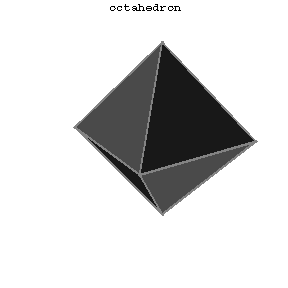Difference between revisions of "Octahedron"
(Importing text file) |
(TeX) |
||
| Line 1: | Line 1: | ||
| − | A solid figure having eight triangular faces, twelve edges and six vertices, with 4 faces at each vertex. If all edges have the same length, it is one of the five regular polyhedra (Platonic solids); if the edge length is | + | {{TEX|done}} |
| + | A solid figure having eight triangular faces, twelve edges and six vertices, with 4 faces at each vertex. If all edges have the same length, it is one of the five regular polyhedra (Platonic solids); if the edge length is $a$, then the volume of the octahedron is | ||
| − | + | $$v=\frac{a^3\sqrt 2}{3}\approx0.4714a^3.$$ | |
<img style="border:1px solid;" src="https://www.encyclopediaofmath.org/legacyimages/common_img/o068100a.gif" /> | <img style="border:1px solid;" src="https://www.encyclopediaofmath.org/legacyimages/common_img/o068100a.gif" /> | ||
| Line 10: | Line 11: | ||
====Comments==== | ====Comments==== | ||
| − | The Schläfli symbol of an octahedron is | + | The Schläfli symbol of an octahedron is $\{3,4\}$. When the edges all have the same length one deals with the regular octahedron, reciprocal to the cube; it can be regarded either as a triangular anti-prism or as a square double-pyramid. As one of the five Platonic polyhedra (cf. [[Regular polyhedra|Regular polyhedra]]; [[Platonic solids|Platonic solids]]) it represents the ancient element air. It occurs in nature as a crystal of chrome alum. In terms of its circumradius as unit of measurement, its six vertices have Cartesian coordinates |
| − | + | $$(\pm1,0,0),\quad(0,\pm1,0)\quad(0,0,\pm1);$$ | |
| − | thus it has edge-length | + | thus it has edge-length $\sqrt2$, inradius $\sqrt{1/3}$ and volume $4/3$. Its 4 pairs of opposite faces (or the 4 diameters of the cube) are freely permuted by the octahedral group $\mathfrak S_4$ of order $4!=24$. |
====References==== | ====References==== | ||
<table><TR><TD valign="top">[a1]</TD> <TD valign="top"> G.T. Bennett, "Deformable octahedra" ''Proc. London Math. Soc. (2)'' , '''10''' (1912) pp. 309–343</TD></TR><TR><TD valign="top">[a2]</TD> <TD valign="top"> H.S.M. Coxeter, "Regular polytopes" , Methuen (1948) pp. 5</TD></TR></table> | <table><TR><TD valign="top">[a1]</TD> <TD valign="top"> G.T. Bennett, "Deformable octahedra" ''Proc. London Math. Soc. (2)'' , '''10''' (1912) pp. 309–343</TD></TR><TR><TD valign="top">[a2]</TD> <TD valign="top"> H.S.M. Coxeter, "Regular polytopes" , Methuen (1948) pp. 5</TD></TR></table> | ||
Latest revision as of 14:08, 30 July 2014
A solid figure having eight triangular faces, twelve edges and six vertices, with 4 faces at each vertex. If all edges have the same length, it is one of the five regular polyhedra (Platonic solids); if the edge length is $a$, then the volume of the octahedron is
$$v=\frac{a^3\sqrt 2}{3}\approx0.4714a^3.$$

Figure: o068100a
Comments
The Schläfli symbol of an octahedron is $\{3,4\}$. When the edges all have the same length one deals with the regular octahedron, reciprocal to the cube; it can be regarded either as a triangular anti-prism or as a square double-pyramid. As one of the five Platonic polyhedra (cf. Regular polyhedra; Platonic solids) it represents the ancient element air. It occurs in nature as a crystal of chrome alum. In terms of its circumradius as unit of measurement, its six vertices have Cartesian coordinates
$$(\pm1,0,0),\quad(0,\pm1,0)\quad(0,0,\pm1);$$
thus it has edge-length $\sqrt2$, inradius $\sqrt{1/3}$ and volume $4/3$. Its 4 pairs of opposite faces (or the 4 diameters of the cube) are freely permuted by the octahedral group $\mathfrak S_4$ of order $4!=24$.
References
| [a1] | G.T. Bennett, "Deformable octahedra" Proc. London Math. Soc. (2) , 10 (1912) pp. 309–343 |
| [a2] | H.S.M. Coxeter, "Regular polytopes" , Methuen (1948) pp. 5 |
Octahedron. Encyclopedia of Mathematics. URL: http://encyclopediaofmath.org/index.php?title=Octahedron&oldid=14196